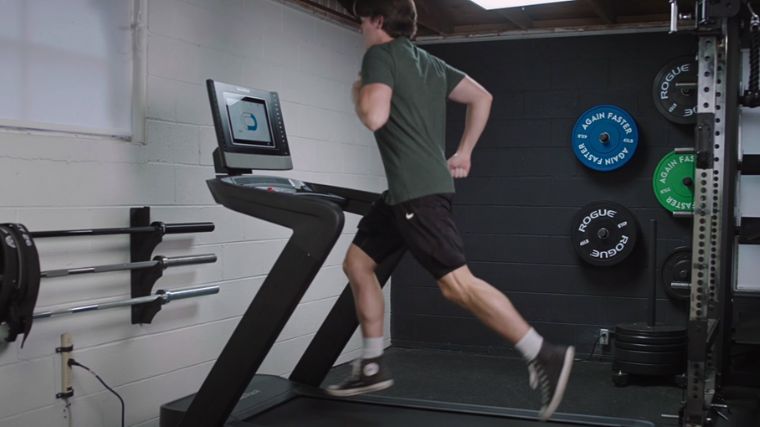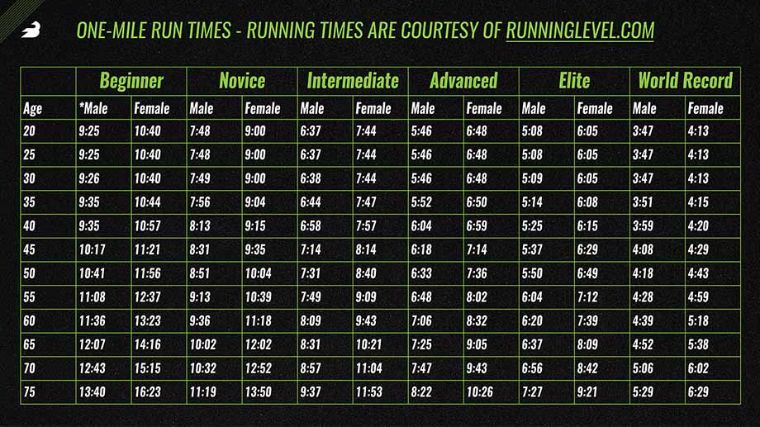There are 5,280 feet in a mile. For distance runners, this distance may be a pittance. For new runners, accomplishing a decent mile might be the ultimate goal. But uniting most runners across the board is the quest to not just run a mile — but to run a mile faster.

For world-class runners, the four-minute-mile still remains a mark of true eliteness, but for other runners, it can be more difficult to identify a one-mile time target worth chasing down. Even harder is figuring out how to run a faster mile. We talked to an elite running coach for you — here are his top tips for improving your mile time.
Editor’s Note: The content on BarBend is meant to be informative in nature, but it should not be taken as medical advice. When starting a new training regimen and/or diet, it is always a good idea to consult with a trusted medical professional. We are not a medical resource. The opinions and articles on this site are not intended for use as diagnosis, prevention, and/or treatment of health problems. They are not substitutes for consulting a qualified medical professional.
5 Tips From a Running Coach for Running a Faster Mile
Running — whether that distance is a mile, a 5k, or an ultra marathon — involves a lot of (literally) moving parts. To help you on your journey to run a faster mile, we’re bringing you advice from an elite running coach, who will lay out some of the best ways to increase your speed for a mile run.
Focus on the Right Things
One of the most common targets for people aiming to improve their mile time is increasing their stride length. The bigger your strides, the logic goes, the faster you’ll be. But artificially focusing on taking longer steps will likely throw off your form. And, it won’t make you stronger or more cardiovascularly fit.
[Read More: How Many Steps Are in a Mile?]
“Your body does a great job of self-selecting,” Whitaker explains. “Stride rate, stride length, and stride frequency are all just math. The faster you run, the longer your stride length is going to be. There are 100 other things that you can work on to get faster before even thinking about those things, and you probably never want to just focus on something like stride length.”
[Read More: Running on a Treadmill Vs. Running Outside]
For more insight into listening to your body while programming and carrying out effective workouts, check out these BarBend articles.
- Autoregulation: Can It Be Beneficial for Every Type of Strength Athlete?
- How to Build Your Own Workout Program (+ Sample Template)
Don’t Overthink Your Form
The first question many people ask about running is related to form. What foot strike should you do? What about your posture? Stride length? And yes, form is critical. But form is made up of a lot of different factors — think about strength training and using the best mobility exercises out there in the background to improve your form.
“Good running form can certainly improve efficiency and improve your time in the mile or at any distance, but I don’t think that you improve form specifically by just working on form,” clarifies Whitaker. “You can address your biomechanics and form through things like strength training and drills. You don’t do it by trying to be conscious about how you’re moving your arms, or where your foot is hitting the ground.”

[Read More: The 9 Best Running Shoes On the Market]
By all means, try to improve those things, Whitaker says. But here’s what you should focus on even more:
- Mobility training and flexibility work
- Running drills to create muscle memory
- Strength training
Develop Your Aerobic System
Your aerobic system is the cornerstone to sustaining an efficient mile pace. So whether you’re trying to get the fastest mile run you’ve ever had or training for a 10k, you must build up your aerobic system. (1)
“Even at a distance like a mile, I tell people not to neglect the aerobic portion of their training,” says Whitaker. “Even as fast as a mile is relative to longer distances like a marathon or a half-marathon, the mile is still primarily an aerobic event.”
To develop your cardiovascular capacity to where you’ll need it to be for your max-effort mile, you’ll actually need to do longer runs. Try interspersing these distances — when your body is ready to handle the volume — into your training runs.
- 2 miles
- 5k (3.1 mile)
- 5 miles
- 10k
Prepare Your Body for the Full Effort
Even if you’re a world-class runner, churning out a fast mile is going to subject your body to at least a few minutes of intense discomfort. Your heart rate will certainly get higher. Beneath its surface, your body is working hard to process and clear lactate, which is a learned process. (2)(3)
This means you should include tempo runs, sprints, and other high-intensity training to prepare your body to run a mile at a race pace.
[Read More: Try This Dynamic Warm-Up for Running]
“Using different types of interval training is certainly going to be beneficial if you want to run a fast mile,” suggests Whitaker. “If you’re kind of early in your training cycle, just improving your aerobic endurance will improve your mile time. Beyond that, you’ll get to a certain level where you need to start looking at the other things like your lactate tolerance, or your lactate threshold, or your VO2 max. Doing workouts at different interval types and different speeds will help you improve each of those markers and lower that mile time.”
Don’t forget that rest days are crucial. But as long as you’re getting enough recovery time, interval training can help a lot. You’ll want to incorporate the following types of running workouts:
Train for Strength
Even though milers are often categorized as distance runners, their performances still benefit greatly from exercises that build strength and power. (4) This means the training programs of runners who routinely compete in one-mile races often include strength training workouts that target the quads and hamstrings.
“Strength training helps runners because stronger muscles can generate more force,” explains Whitaker. “It just makes our muscles and our skeletal system more resilient so that we can then do more intervals or more mileage with [reduced injury risk]. The increased strength that we get allows us to actually run more.”
[Read More: How to Strength Train for Your 5K (and Why You Should)]
This is why Whitaker programs his athletes with the following exercises:
- Squats
- Deadlifts
- Lunges
- Additional best leg exercises
What’s a Good Mile Time?
As with anything in strength sports, “good” is relative. How much experience do you have? What are your goals? Below, you’ll find some guidance for assessing your mile time relative to other people of similar ages and genders at your experience level.

[Read More: How to Balance Running and Strength Training, No Matter Your Goals]
The data above defines runners’* experience levels as follows:
- Beginner: Faster than five percent of runners. A beginner runner has started running and has run for at least a month.
- Novice: Faster than 20 percent of runners. A novice runner has run regularly for at least six months.
- Intermediate: Faster than 50 percent of runners. An intermediate runner has run regularly for at least two years.
- Advanced: Faster than 80 percent of runners. An advanced runner has run for over five years.
- Elite: Faster than 95 percent of runners. An elite runner has dedicated over five years to becoming competitive at running.
More data is needed on nonbinary runners. It may be worth noting that the New York Road Runners (half-marathon and marathon) and the Boston Marathon have equated the qualifying standards of their non-binary categories with their female categories.
How Often Should You Test Your Max Mile Time?
As you capitalize on these training tips for how to run a faster mile, you will be tempted to hit the track and repeatedly test your speed. This is where you’re going to need to keep your excitement in check and show some restraint. Although a timed trial has its place in your training plan, repeatedly pushing yourself can increase your risk of injury.
Doing a mile every day as fast as you can do it is going to be pretty bad for you; even once a week is too much.
“If you’re running an all-out mile, the recovery time is probably multiple days, and it might take more than 72 hours to recover from running a mile depending on your age, fitness level, and experience,” warns Whitaker. “We like to test about every three to five weeks to kind of get a sense of where we are … [For athletes that may be slower to recover], we test typically two to three times per 16-week training cycle.”
[Read More: The 9 Best Running Apps We’ve Tried and Tested]
Your Takeaways
Over the long run, you’re not going to improve your mile time by forcing yourself to run a mile as fast as you can, as often as you can. Instead, try these strategies for running a faster mile:
- Instead of arbitrarily trying to take longer strides to force yourself into getting faster, focus on mobility, flexibility, strength training, and running drills to improve your form.
- Go on longer runs to improve your aerobic capacity.
- Incorporate speed work like sprints into your training program.
- Do strength training workouts to help your legs and overall lower body get stronger — this will support faster, more powerful running.
FAQs
If you need a concise list of helpful tips to help you run faster, the answers to the questions below will have you speeding along in no time.
How can I make my mile time faster?
There are several ways you can improve your mile time. These include boosting your aerobic efficiency, increasing your lower-body strength, and training your body in such a way that it can tolerate lactate and efficiently clear it from your system.
Is running a six-minute mile good?
A time in the vicinity of a six-minute mile is in the advanced range for a runner of any gender. It also exceeds the entire range of elite mile times for people who are assigned female at birth, regardless of age.
What exercises can help me run a mile faster?
Lower-body strength training exercises like squats, deadlifts, and lunges are exercises that can make runners stronger, faster, and more durable. Beyond that, runs of varying lengths and intensities can also reliably help you to run a faster mile.
References
- Denadai BS, Greco CC. Could middle- and long-distance running performance of well-trained athletes be best predicted by the same aerobic parameters? Curr Res Physiol. 2022 Jun 23;5:265-269.
- Stallknecht B, Vissing J, Galbo H. Lactate production and clearance in exercise. Effects of training. A mini-review. Scand J Med Sci Sports. 1998 Jun;8(3):127-31.
- Menzies P, Menzies C, McIntyre L, Paterson P, Wilson J, Kemi OJ. Blood lactate clearance during active recovery after an intense running bout depends on the intensity of the active recovery. J Sports Sci. 2010 Jul;28(9):975-82.
- Prieto-González P, Sedlacek J. Effects of Running-Specific Strength Training, Endurance Training, and Concurrent Training on Recreational Endurance Athletes’ Performance and Selected Anthropometric Parameters. Int J Environ Res Public Health. 2022 Aug 29;19(17):10773.
Featured Image: G-Stock Studio / Shutterstock